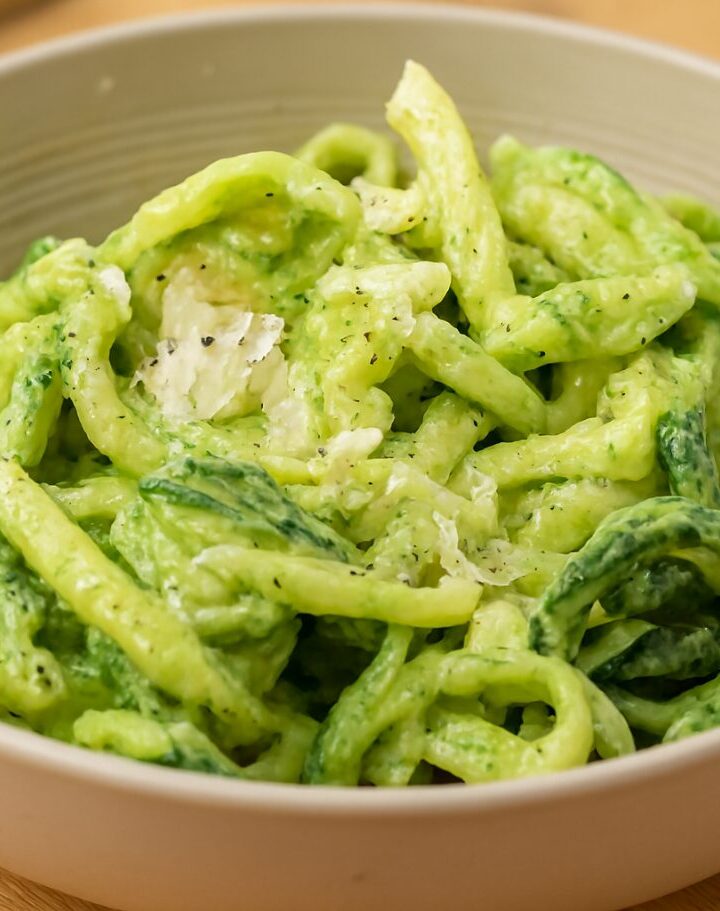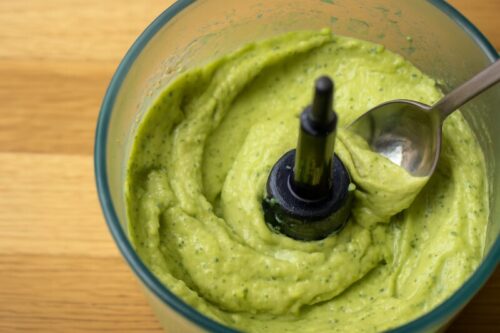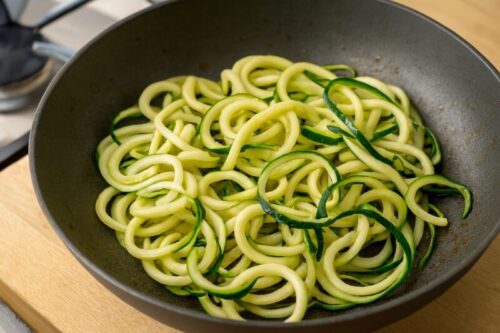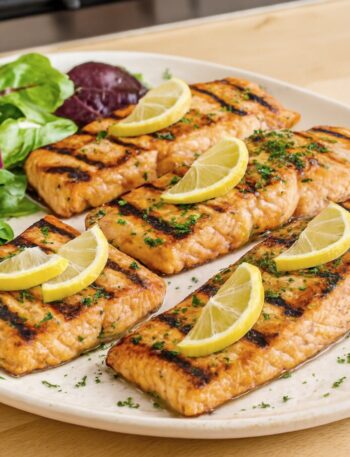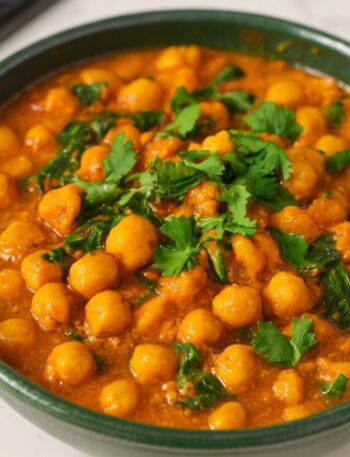If you’re looking for a quick and light dinner idea, this Zucchini Pasta with Avocado Pesto is a good option.
Instead of regular pasta, it uses zucchini noodles, also called zoodles. Zucchini is low in carbs and gluten-free, so it’s suitable for people who want a lighter meal or need to avoid gluten.
The sauce is made by blending avocado, basil, and lemon juice. It has a creamy texture and a fresh taste. You can also add a little salt, olive oil, and garlic if you want more flavor.
If you’re short on time, you can buy ready-made zoodles from the store. That makes the recipe even faster. Just cook the zoodles lightly in a pan, mix in the avocado pesto, and it’s ready to serve.
The whole dish takes about 15 minutes to prepare. It’s simple, healthy, and doesn’t require many ingredients.
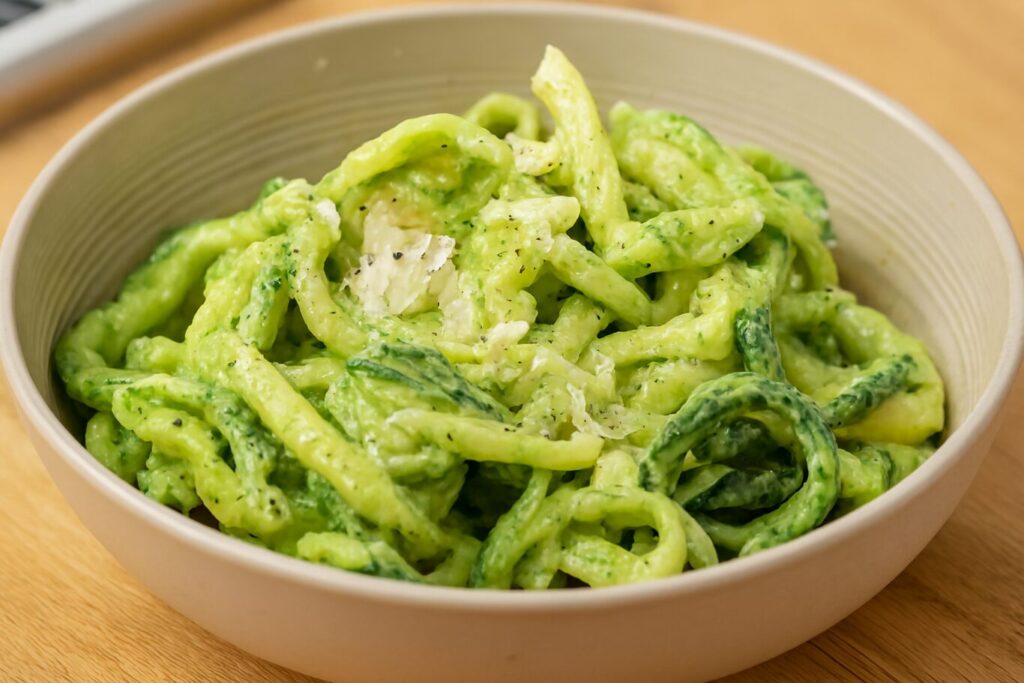
Zucchini Noodles With Avocado Pesto
Description
Zucchini Pasta with Avocado Pesto is a light and refreshing healthy dish. Instead of regular pasta, it uses zucchini noodles. The creamy pesto sauce is made from avocado, basil, and lemon, which gives it a smooth texture and fresh flavor. This recipe is a good choice for people looking for gluten-free or low-carb meals. It’s quick to make and works well as a cooling meal during summer.
Ingredients
For the Pesto Sauce:
For the Zucchini Noodles (Zoodles):
For Garnish (Optional):
Instructions
- Take a blender or food processor and add the following ingredients: 1 ripe avocado (peeled and seed removed), 1 clove of garlic (peeled), ½ cup fresh basil leaves (washed), 1 tablespoon lemon juice (fresh is better).
- Blend everything for a few seconds until it starts to come together. Add 2 tablespoons of olive oil and blend again until smooth.
- If the sauce feels too thick, add a little water, one spoon at a time, and blend again. Keep adding water until the sauce becomes smooth and creamy.
- Now, add salt and black pepper to taste. Blend one last time to mix everything well. Your avocado pesto is ready. Set it aside.

- Take 2 to 3 medium-sized zucchinis. Wash them and cut off the ends.
- Use a spiralizer to make long, noodle-like strands. If you don’t have a spiralizer, you can use a vegetable peeler to make thin strips, like fettuccine.
- Now, heat 1 to 2 teaspoons of olive oil in a pan on medium heat. Add the zucchini noodles to the pan. Sauté them for about 3 to 5 minutes, just until they become slightly soft but still hold their shape. They should look bright green.
- Turn off the heat and let them cool for a few minutes.
- Zucchini releases water when cooked. If you want, you can sprinkle a little salt on the raw zoodles and let them sit for 10-15 minutes before cooking. Then gently squeeze out the extra water using a clean towel or paper towel.

- Once the zoodles have cooled slightly, place them in a large mixing bowl. Pour the avocado pesto sauce over the zoodles.
- Mix everything well so that the sauce coats all the noodles evenly. You can taste and adjust the seasoning. Add more salt, pepper, or lemon juice if needed.

- If you like, sprinkle some grated parmesan cheese or crushed nuts on top for extra flavor. Then, serve immediately.
Step 1: Make the Avocado Pesto
Step 2: Prepare the Zucchini Noodles (Zoodles)
Step 3: Mix and Serve
Pro Tips & Variations
Pro Tips:
- Remove water from zoodles: Zucchini contains a lot of water, so the noodles can become soggy. If you want to reduce the moisture, you can sprinkle a little salt over the raw zoodles and leave them for about 15 minutes. After that, use a paper towel or clean kitchen towel to gently press and dry them. This helps prevent the sauce from becoming too thin when you mix everything together.
- Adjust pesto consistency: Sometimes the avocado pesto turns out too thick. In that case, you can add a little water or olive oil, one spoon at a time, and blend again. Keep checking the texture as you go. Just make sure not to add too much liquid, or the sauce will become runny and won’t stick well to the noodles.
- Balance the flavor: Avocado can taste a bit plain on its own. So if the sauce feels bland, you can add a little extra lemon juice or one more garlic clove. This will make the flavor stronger and fresher. You can also add a pinch of chili flakes if you want a little heat.
- Keep pesto from turning dark: Avocado tends to turn brown quickly when exposed to air. So once the sauce is ready, it’s best to use it right away. If you need to store it, you can pour a thin layer of olive oil on top before closing the container. This helps slow down the browning and keeps the sauce looking fresh.
- Improve the texture: If you want the pesto to feel creamier and richer, you can add a spoonful of grated parmesan cheese or a few cashews while blending. This gives the sauce a smoother texture and a slightly nutty taste.
Variations:
- Add some protein: If you want to make the dish more filling, you can add grilled chicken, paneer cubes, or cooked shrimp. Just mix them in after the zoodles and sauce are combined. This turns it into a more complete meal.
- Make it vegan or dairy-free: If you don’t want to use cheese, you can sprinkle some nutritional yeast on top. It gives a mild cheesy flavor without using any dairy. This works well for vegan versions.
- Use other vegetables instead of zucchini: If you don’t have zucchini, you can try making noodles from cucumber, carrot, or sweet potato. Just slice them thinly using a spiralizer or peeler. Cooking time may vary slightly depending on the vegetable.
- Add some crunch: To make the texture more interesting, you can top the dish with cherry tomatoes, roasted almonds, or sunflower seeds. These add a little crunch and extra flavor.
- Serve it cold as a salad: If the weather is hot, you can chill the dish in the fridge and eat it cold. The flavors stay fresh, and the cold version feels more refreshing, especially during summer.
Storage & Reheating Instructions
Storage Instructions:
- If you have any leftover zucchini pasta, you can put it in an airtight container and keep it in the fridge. This helps maintain the flavor and texture, and it keeps the food fresh for longer.
- You can store it in the fridge for up to 3 days. After that, the avocado pesto may start to change color and taste. So it’s better to eat it within that time.
- If you want to keep the zucchini noodles from getting soggy, it’s a good idea to store the avocado pesto and the noodles in separate containers. Then, when you’re ready to eat, you can mix them together. This helps keep the texture better.
- This recipe doesn’t freeze well. That’s because both avocado and zucchini release water after freezing, which can make the texture mushy and the taste less fresh. So it’s best to avoid freezing it.
- Avocado turns brown quickly when exposed to air. So if you’re storing the sauce, you can pour a thin layer of olive oil on top before closing the lid. This helps keep the green color and slows down browning.
Reheating Instructions:
- If you’re reheating on the stove, take a pan and add a little water or olive oil. Then heat the pasta on low flame for 2 to 3 minutes. Just warm it enough so the sauce becomes smooth again. Don’t overheat it.
- If you’re in a hurry, you can use the microwave. Put the pasta in a microwave-safe bowl and sprinkle a little water or olive oil on top. This helps keep the sauce from drying out. Heat it in 30-second intervals until it’s warm.
- You can also eat this pasta cold. It tastes good even without reheating, especially if you’re packing it for lunch or eating it during hot weather. The cold version feels fresh and light.
- Try not to overheat the pasta, because zucchini gets soft very quickly and may become sticky. Just warm it lightly so the texture stays nice.
- Sometimes the sauce may feel dry after reheating. In that case, you can add a little olive oil or lemon juice and mix well. This helps bring back the creamy texture.
Serving Suggestions:
- Add Cheese Before Serving: To make the dish taste a little richer, you can grate some parmesan cheese on top. It adds a mild salty flavor and makes the pasta feel more complete. If you are keeping the recipe vegan, you can use nutritional yeast instead of cheese. It gives a cheese-like taste but doesn’t contain any dairy.
- Add Toppings Before Serving: If you want some crunch, you can add roasted almonds or cashews on top. This gives a nice texture and makes the dish feel more interesting.
- Add Simple Sides: If you want to keep the meal light, you can serve it with garlic bread or toasted whole wheat bread. These go well with the pasta and help make the meal more filling. You can also prepare a small green salad or tomato salad. Both are easy to make and add a fresh taste to the plate. Tomato or vegetable soup is also a great option.
- When and How to Eat It: This zucchini pasta works well for both lunch and dinner. It’s light but still satisfying. If the weather is hot, you can chill the pasta and eat it cold like a salad. The flavors stay fresh and it feels more refreshing.
- Small Things to Keep in Mind While Serving: Before serving, you can squeeze a little lemon juice over the pasta. This adds freshness and improves the overall taste. If you made the pasta earlier, just drizzle a little olive oil before serving. This helps keep the noodles from feeling dry. Make sure to add a few basil leaves or some cherry tomatoes on top.
Nutrition Facts
Servings 2
Serving Size 1 bowl (approx. 250g)
- Amount Per Serving
- Calories 380kcal
- % Daily Value *
- Total Fat 30g47%
- Saturated Fat 4g20%
- Trans Fat 1g
- Sodium 160mg7%
- Potassium 900mg26%
- Total Carbohydrate 20g7%
- Dietary Fiber 8g32%
- Sugars 6g
- Protein 8g16%
- Vitamin A 500 IU
- Vitamin C 25 mg
- Calcium 60 mg
- Iron 1.8 mg
* Percent Daily Values are based on a 2,000 calorie diet. Your daily value may be higher or lower depending on your calorie needs.
FAQ
Q1. Can I make the avocado pesto ahead of time?
Yes, but just keep in mind that avocado turns brown quickly, so it’s better to store the pesto in an airtight container. Also, it helps if you pour a little olive oil on top before closing the lid. This way, the color stays green and the texture stays smooth. You can keep it in the fridge for 2 to 3 days. But don’t freeze it, because freezing changes the texture and color, and it won’t taste the same after thawing.
Q2. Zucchini noodles release water . How can I stop that?
This is normal because zucchini has a lot of water in it. If you want to reduce the moisture, you can sprinkle a little salt over the raw noodles and leave them for about 15 minutes. After that, gently press them with a paper towel to remove the extra water. Also, try not to sauté them for too long. If you cook them for too long, they will become soft and watery, and the texture won’t be as good.
Q3. What if I don’t have fresh basil?
If you don’t have fresh basil, you can use dried basil instead. Just use a smaller amount, since dried herbs are stronger in flavor. Or, if you want, you can try using spinach or cilantro as a replacement. The taste will be a little different, but it will still work fine in the recipe.
Q4. Is this recipe vegan and gluten-free?
Yes, this recipe is both vegan and gluten-free. Just remember that if you add parmesan cheese on top, it’s not vegan because it contains dairy. If you want to keep it vegan, you can use nutritional yeast instead of cheese. It gives a similar flavor and keeps the recipe dairy-free.
Q5. Can I use store-bought zoodles?
Yes, but just make sure to buy fresh ones, not frozen. Frozen zoodles usually have more water and can become soggy after cooking. If you’re using packaged zoodles, it’s a good idea to pat them dry with a paper towel before cooking. This helps remove any extra moisture and keeps the texture better.

